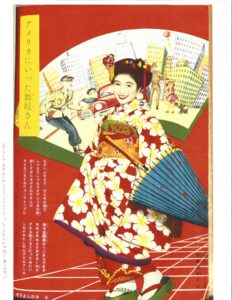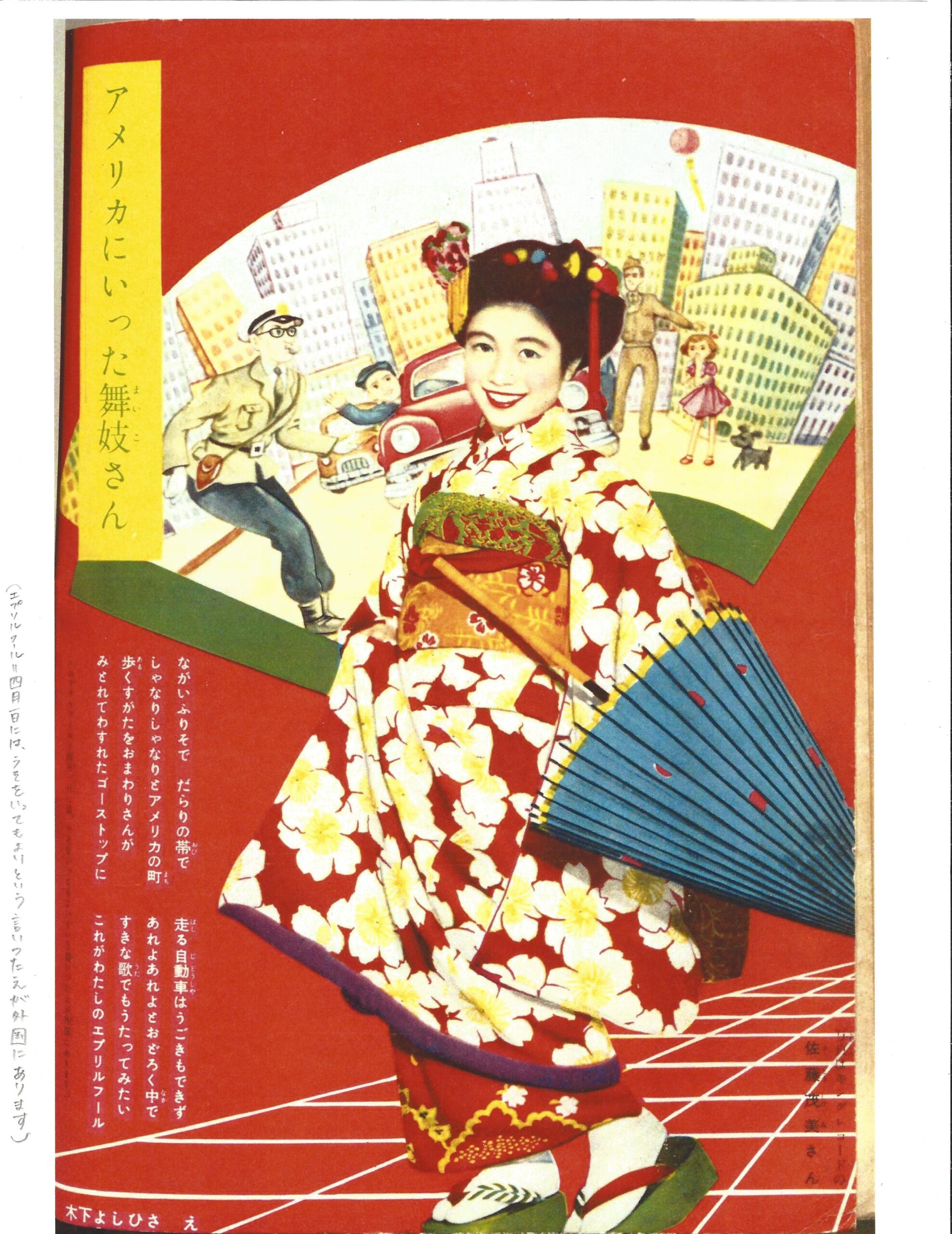
The Maiko who went to America,“Amerika ni itta maiko-san.” Artist Kinoshita Yoshihisa. Shōjo magazine, April 1, 1954 (illustration within magazine; Kobunsha, publisher).
Here’s a delightful maiko image for celebrating the beginning of April. Happy April Fool’s Day!
This story features Satō Shigemi 佐藤茂美, a popular young singer of children’s songs who recorded with King Records. Here, she plays the role of a maiko.
The Maiko who went to America
The text alongside the image goes something like this:
“Captivated by the sight of the maiko walking gracefully in the American city in her furisode kimono and darari obi, the patrol officer forgets all about directing the traffic. The cars on the road are unable to move. Looking on in surprise, the maiko feels like singing one of her favorite songs.” ”This is my April’s Fool prank.”
The comic image of the maiko abroad
 Artist Kinoshita imagines a policeman directing traffic in New York City. Everything comes to a stop when the man is enchanted by the flowing sleeves and long obi worn by an adorable maiko. An American serviceman and a little girl standing nearby seem equally surprised. With her pretty blue parasol, colorful kimono, and kanzashi hair ornaments, the maiko makes a fetching—and traffic-stopping— sight.
Artist Kinoshita imagines a policeman directing traffic in New York City. Everything comes to a stop when the man is enchanted by the flowing sleeves and long obi worn by an adorable maiko. An American serviceman and a little girl standing nearby seem equally surprised. With her pretty blue parasol, colorful kimono, and kanzashi hair ornaments, the maiko makes a fetching—and traffic-stopping— sight.
Shōjo, a magazine for girls
This story comes from the April 1954 Shōjo (Girl). A monthly illustrated magazine, Shōjo introduced movies and teen stars such as Satō Shigemi. Shōjo carried lots of fiction and manga appealing to girl readers (Kikuyo Library). Kōbunsha published Shōjo from 1949 to 1963. In Maiko Masquerade, I write about the maiko as shōjo.
References
Kikuyo Library: https://www.kikuyo-lib.jp/?page_id=182
Accessed February 11, 2021.
For analysis of Japanese magazines for girls, see Sarah Frederick. “Girls’ Magazines and the Creation of Shōjo Identities.” In Routledge Handbook of Japanese Media, edited by Fabienne Darling-Wolf, 22–38. London: Taylor and Francis, 2018.
Jan Bardsley, “A Maiko April Fool’s Day Story,” https://janbardsley.web.unc.edu/ April 1, 2021.

Wonderful….the image really captures the playful and charming Maiko, the astonishment of the traffic policeman and driver of the car, the little girl’s total fascination and awe, and this delightful moment taking place with the towering NYC skyscrapers in the background. Dare I say a “Norman Rockwell” image?
Happy April 1st, Vicki! Norman Rockwell is such a good comparison. I hadn’t thought of that. But there’s that same cheerfulness, and he did lots of funny stories, too. A few years back the NC Art Museum had a huge Rockwell show and it was so much fun to see it. I really love this April maiko’s image and I’m so glad it’s finally April Fool’s Day so I could use it. Jan
Was maiko one of the icons among Japanese girls at that time? I’m interested in the reason why did maiko appear in a girls magazine.
Thanks, Haruka. What an interesting question! We know that in 1950s Kyoto, maiko images were on all kinds of souvenirs and artwork. But I didn’t find much evidence of the maiko as a symbol of charming girlhood in the 1950s as she is today. This is a curious choice for the Shoujo magazine.